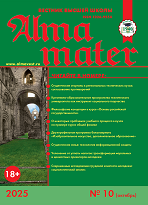UDC 152.92:378
https://doi.org/10.20339/AM.04-20.042
Fabrice S.N. Fosso is PhD student in Sociology at Ural Federal University
Universities still struggle with the ebbs and flows consisting of attracting, retaining and understanding foreign students. Too much focus via surveys is put on their perception of the quality of teaching, their adaptation, or performance appraisal. An approach which is questionable from a sociological point of view, and can be described as a stagnation in higher education, the sociology of education, and related social sciences, given that those opinions derived in most cases are, we argue, out of their contexts of study. For instance, the social representations of crime, mega events, or public transport, which all combined together, and evolutive and modifiable as foreign students experience the social context, determine the final social representation of higher education. Therefore, this article suggests the theory of social representations, and some theoretical suggestions to fill the gap related to investigations on foreign students. Some previously implemented research methods on the topic are also discussed as to propose a multiapproach when it comes to the social representations of higher education of foreign students.
Keywords: social representations, foreign students, higher education.
References
- Höijer, B. (2011). Social Representations Theory: A New Theory for Media Research. Nordicom Review , 32(2), 3–16.
- Lo Monaco, G., Piermattéo, A., Rateau, P., & Tavani, J.L. (2016). Methods for Studying the Structure of Social Representations: A Critical Review and Agenda for Future Research. Journal for the Theory of Social Behaviour, 47(3), 306–331.
- Lopes da Silva, A. (2012). social representations of undergraduates about teacher identity and work a gender perspective. Educação, Sociedade & Culturas, 36, 49–64.
- Abric, J. (1994). Pratiques sociales et representations. Paris: PUF.
- Abric, J.-C. (1993). Central system, peripheral system: their functions and roles in the dynamics of social representations. Papers on Social Representations, 2(1), 75–78.
- Alemu, A. M., & Cordier, J. (2017). Factors Influencing International Student Satisfaction in Korean Universities. Journal of Educational Development, 57(Nov), 54–64.
- Andrade, S. M. (2006). International students in English-speaking universities: Adjustment factors. Journal of Research in International Education, 5(2), 131–154.
- Antonova, N., Abramova, S., Grunt, E., Merenkov, A., & Dronishinets, N. (2019). Student's Territorial Mobility (Example of Yekaterinburg). Shenzhen: DEStech Publications, Inc.
- Breakwell, M. G. (1993). Social representations and social identity. Papers on Social Representations, 2(1), 198–217.
- Breakwell, M., & Canter, D. (1993). Empirical approaches to social representations (ed. 1). London: Oxford University Press.
- Doise, W. (2005). Les représentations sociales. В P. s. In N. Dubois (Ed.). Social psychology of cognition (Р. 153–207). Paris: Dunod.
- Doise, W., Clémence, A., & Lorenzi-Cioldi, F. (1993). The quantitative analysis of social representations. Hemel Hempstead: Harvester Wheatsheaf.
- Flament, C. (1981). L’analyse de similitude:une technique pourl’étudedesreprésentations sociales. Cahiers de Psychologie Cognitive, 1(1), 375–395.
- Jodelet, D. (1989). Représentations sociales: un domaine en expansion. Paris: Presses Universitaires de France.
- Lahlou, S. (2001). Functional aspects of social representations. В K. Deaux (Ред.), Representations of the social: bridging theoretical traditions (Р. 131–146). Oxford: Blackwell.
- Merenkov, A., & Antonova, N. (2015). Problems of social adaptation of international students in Russia. New Educational Review, 41(3), 122–132.
- Moliner, P. (1993). Cinq questions à propos des représentations. Les cahiers internationaux de psychologie sociale, 20(1), 5–13.
- Moliner, P. (2001). Formation et stabilisation des représentations sociales. В Moliner (Ред.), La dynamique des représentations sociales (Р. 15–41). Grenoble: PUG.
- Moscovici, S. (1993). Introductory Address. Papers on Social Representations, 2, 1–11.
- Palmonari, A., & Emiliani, F. (2009). Paradigmi delle rappresentazioni soci ali. Bologna: Il Mulino.
- Pardal, L., Albuquerque, D., Lopes, M., & Ferra0, M.E. (2013). Statistical Evidence on Social Representations of Teachers in Argentina, Brazil and Portugal. Procedia — Social and Behavioral Sciences, 82(2013), 734–739.
- Pianelli, C., Abric , J.-C., & Saad, F. (2010). Rôle Des Représentations Sociales Préexistantes Dans Les Processus D'ancrage Et De Structuration D'une Nouvelle Représentation. Les Cahiers Internationaux de Psychologie Sociale, 86(February), 241–274.
- Rateau, P., Moliner, P., Guimelli, C., & Abric, J.-C. (2011). Social Representation Theory. В A. W. P. A. M. Van Lange (Ред.), Handbook of theories of social psychology (Р. 477–487). Thousand Oaks: Sage.
- Rouquette, M.-L. (1994). Sur la connaissance des masses. Grenoble: PUG.
- Souchet, L., & Girandola, F. (2013). Double foot-in-the-door, social representations, and environment: application for energy savings. Journal of Applied Social Psychology, 43(2), 306–315.
- Stromquist, P. N., & Monkman, K. (2014). Globalization and education: Integration and contestation across cultures (ed. 2). Plymouth: R&L Education.
- Vale, S., & Maciel, H. R. (2019). The Structure of Students’ Parents' Social Representations of Teachers. Trends in Psychology, 27, 265–278.
- Vergès , P. (2001). L'analyse des représentations sociales par questionnaires. Revue française de sociologie, 42(3), 537–561.
- Vergès, P. (1994). Approche dunoyau central: Propriétés quantitatives et structurales. В.C. Guimelli (Ред.), Structures and transformations of social representations (Р. 233–253). Paris: Delachaux et Niestlé.
- Vishnevsky, R. Y., & Narkhov, Y. D. (2019). Paradoxes of the higher education modernization: Results of the 20year monitoring in the Sverdlovsk Region. RUDN Journal of Sociology, 19(2), 289–301.
- Windzio, M., Simonson, J., Pfeiffer, C. & Kleimann, M. (2007). Kriminalitätswahrnehmung und Punitivität in der Bevölkerung — Welche Rolle spielen die Massenmedien? Ergebnisse der Befragungen zu Kriminalitätswahrnehmung und Strafeinstellungen 2004 und 2006. Hannover: KFN.











.png)






